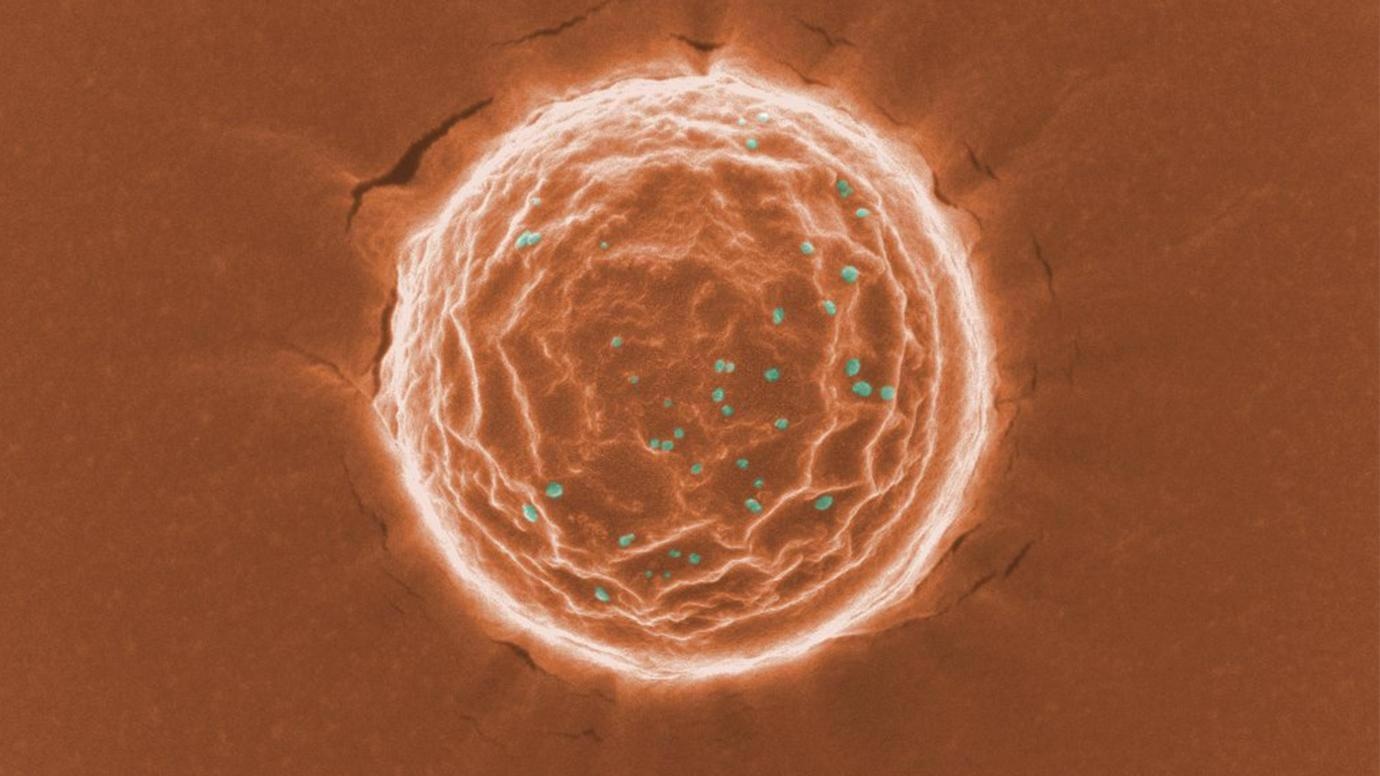Apr 28 2021
At the University of Chicago, scientists have developed an absolutely innovative, promising treatment for COVID-19 in the form of nanoparticles with the ability to trap SARS-CoV-2 viruses inside the body and use the body’s own immune system to kill them.
 A scanning electron microscope image of a nanotrap (orange) binding a simulated SARS-CoV-2 virus (dots in green). Scientists at the University of Chicago created these nanoparticles as a potential treatment for COVID-19. Image Credit: Chen and Rosenberg et al.
A scanning electron microscope image of a nanotrap (orange) binding a simulated SARS-CoV-2 virus (dots in green). Scientists at the University of Chicago created these nanoparticles as a potential treatment for COVID-19. Image Credit: Chen and Rosenberg et al.
The “nanotraps” lure the virus by imitating the target cells infected by the virus. When the virus gets trapped by the nanotraps, it is then sequestered from other cells and targeted for destruction by the immune system.
Theoretically, these nanotraps could be used on different variants of the virus, resulting in a promising new way to suppress the virus in the future. The therapy is still in the early stages of testing, but the researchers believe that it could be administered through a nasal spray as a treatment for COVID-19.
The findings of the study were published in the journal Matter on April 19th, 2021.
Since the pandemic began, our research team has been developing this new way to treat COVID-19. We have done rigorous testing to prove that these nanotraps work, and we are excited about their potential.
Jun Huang, Assistant Professor, Pritzker School of Molecular Engineering
The study was led by Huang’s lab.
Designing the Perfect Trap
Led by postdoctoral scholar Min Chen and graduate student Jill Rosenberg, the researchers designed the nanotrap by analyzing the mechanism used by SARS-CoV-2 to bind to cells—a spike-like protein on its surface that attaches itself to the ACE2 receptor protein found on a human cell.
They developed a trap that would attach to the virus similarly by designing nanoparticles with a high density of ACE2 proteins on their surface. They also developed other nanoparticles with neutralizing antibodies on their surfaces (such antibodies form within the body when someone is infected and are designed to bind to the coronavirus in different ways).
The nanoparticles are made of FDA-approved polymers and phospholipids with a diameter of about 500 nm—quite smaller than a cell. This implies that the nanotraps can reach more areas within the body and capture the virus more effectively.
To ensure the tiny particles appeared the same way they expected, the researchers collaborated with the lab of Associate Professor Bozhi Tian to employ electron microscopes to achieve a better look.
From our imaging, we saw a solid core and a lipid bilayer shell. That’s the essential part because it mimics the cell.
Bozhi Tian, Associate Professor, Department of Chemistry, University of Chicago
The safety of the system was tested by the researchers in a mouse model, and no toxicity was found. Then, the nanotraps were tested against a pseudovirus, which is a less potent model of a virus that does not replicate, in human lung cells in tissue culture plates. It was found that they totally blocked the entry of the pseudovirus into the cells.
As soon as the pseudovirus attached itself to the nanoparticle—which took about 10 minutes after injection during the tests—the nanoparticles used a molecule that summons the macrophages in the body to engulf and disintegrate the nanotrap.
In general, macrophages eat nanoparticles inside the body. However, the nanotrap molecule accelerates the process. It was found that the nanoparticles were cleared and disintegrated within 48 hours.
The nanoparticles were also with a pseudovirus in an ex vivo lung perfusion system—a pair of donated lungs maintained alive with a ventilator—and it was discovered that they totally blocked infection in the lungs.
Moreover, they collaborated with scientists at Argonne National Laboratory to test the nanotraps using a live virus (instead of a pseudovirus) in an in vitro system. Their system was found to inhibit the virus 10 times better than neutralizing antibodies or soluble ACE2 alone.
A Potential Future Treatment for COVID-19 and Beyond
As a next step, the team plans to further test the system with more tests by using a live virus and on several variants of the virus.
That’s what is so powerful about this nanotrap. It’s easily modulated. We can switch out different antibodies or proteins or target different immune cells, based on what we need with new variants.
Jill Rosenberg, Graduate Student, University of Chicago
It is viable to store the nanotraps in a standard freezer and eventually administer them through an intranasal spray. This would introduce them directly to the respiratory system and render them most effective.
According to the researchers, it can also be used as a vaccine by improving the formulation.
This nanomaterial engineering approach provides a versatile platform to clear viruses, and paves the way for designing next-generation vaccines and therapeutics.
Jiuyun Shi, Study Co-Author and Graduate Student, University of Chicago
“This is the starting point. We want to do something to help the world,” added Huang.
Journal Reference:
Chen, M., et al. (2021) Nanotraps for the containment and clearance of SARS-CoV-2. Matter. doi.org/10.1016/j.matt.2021.04.005.